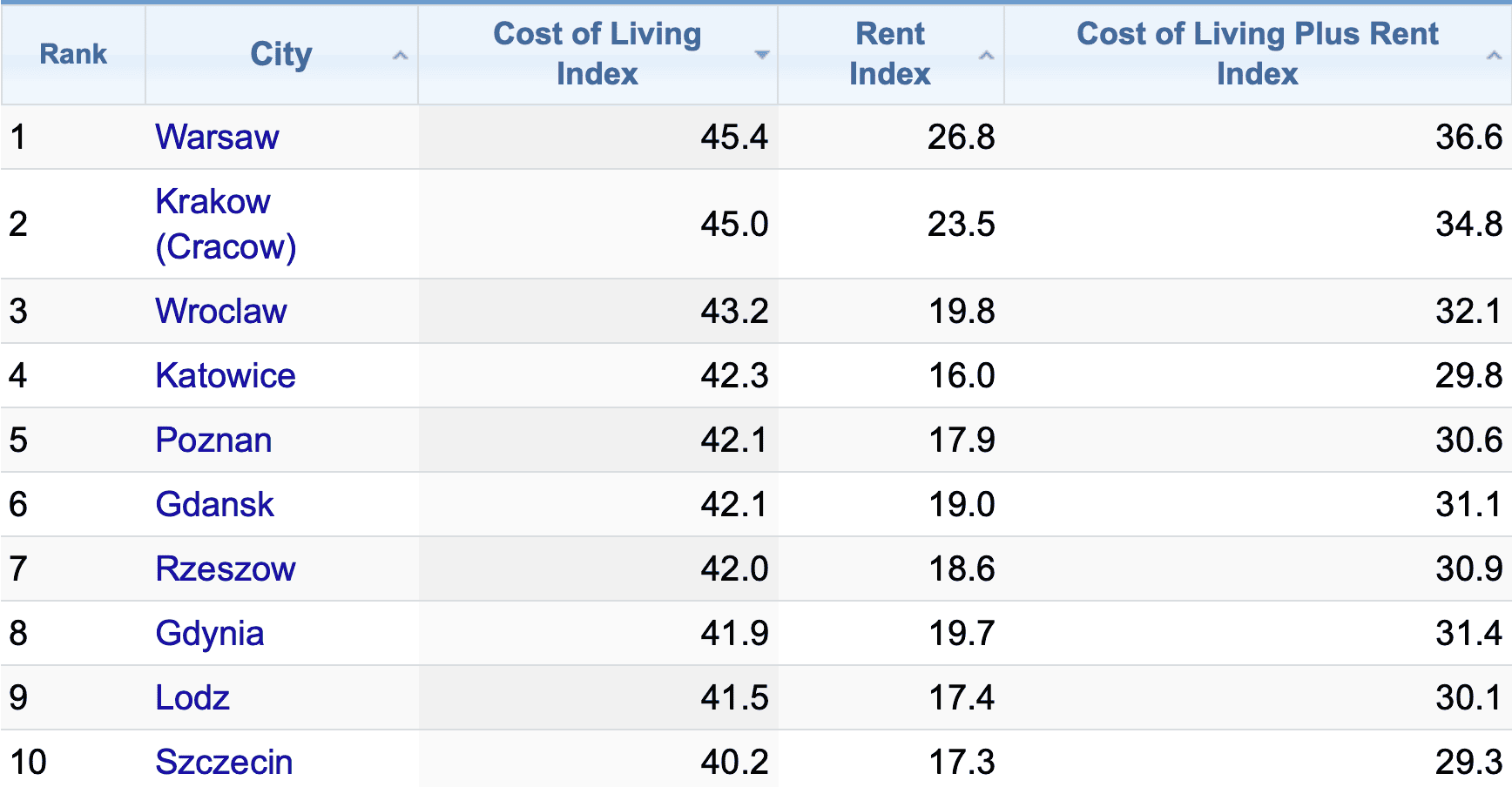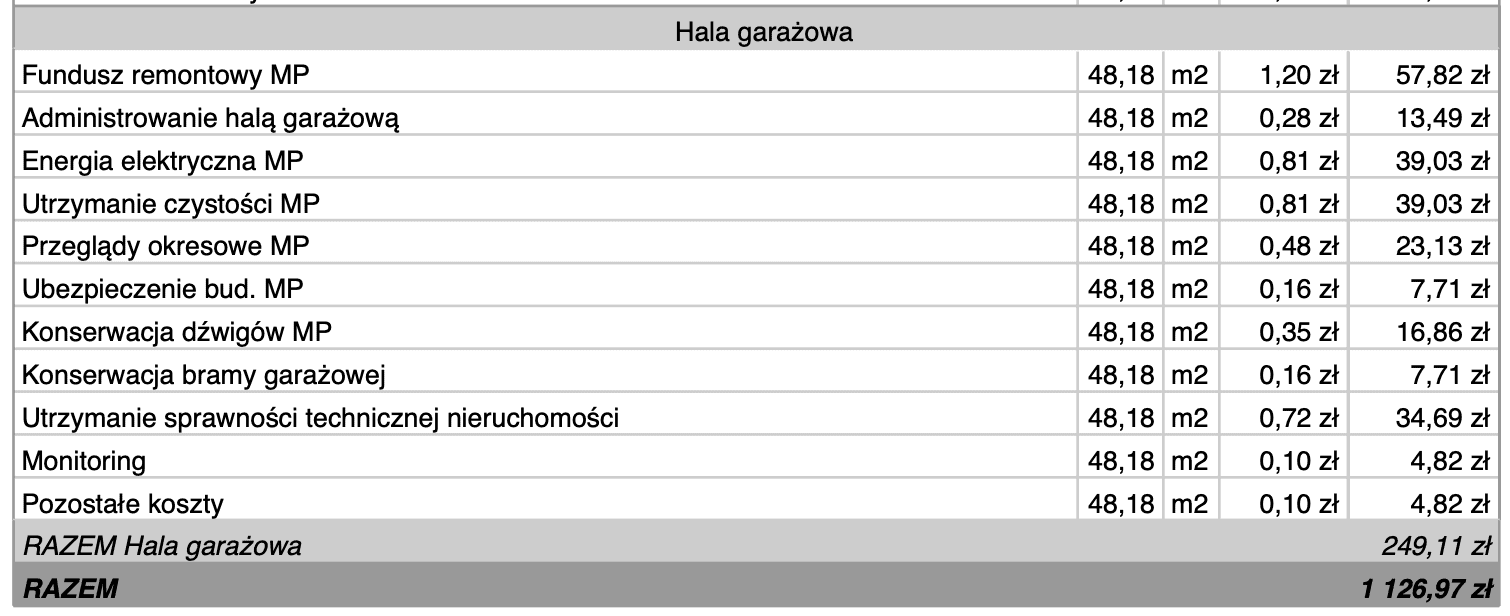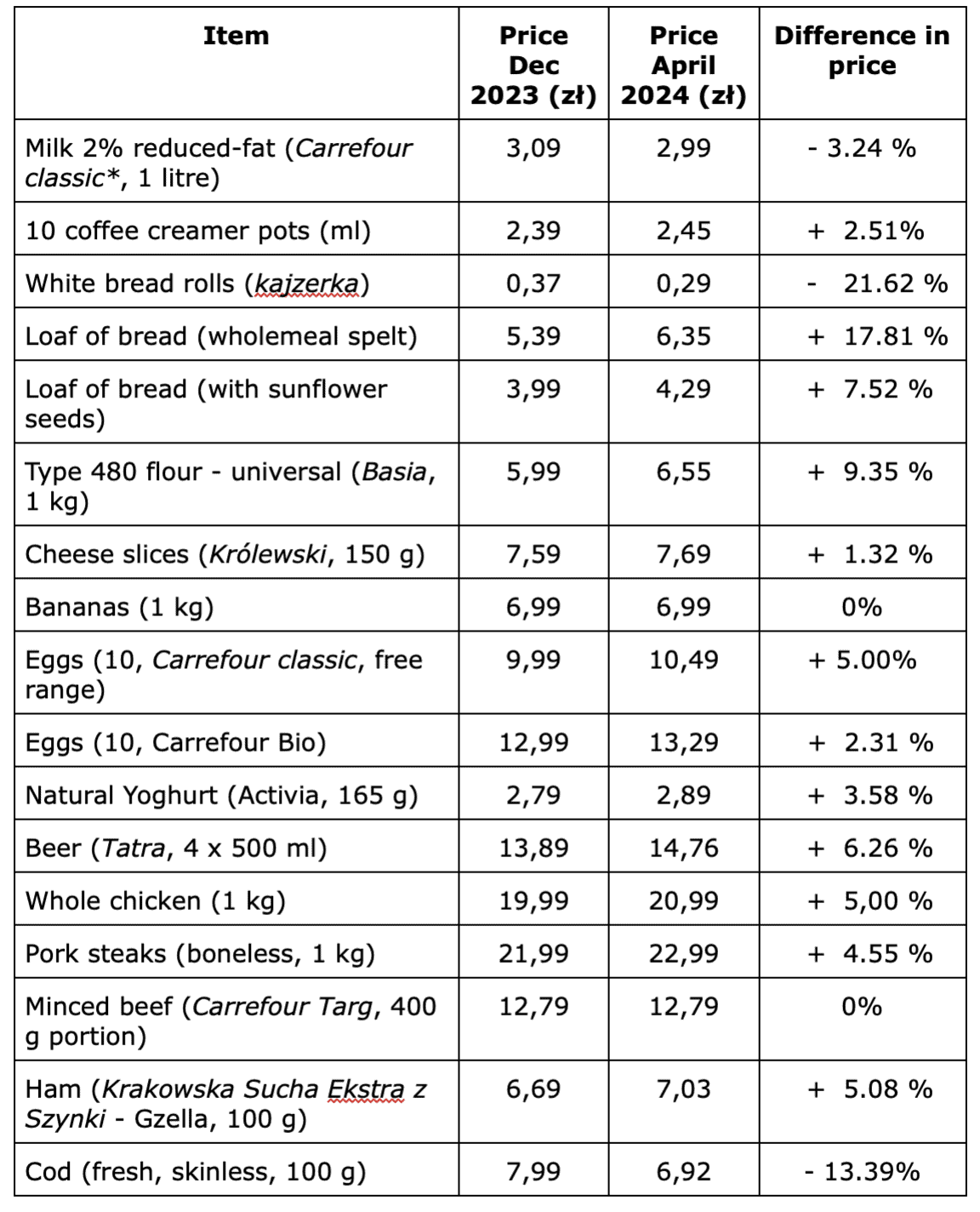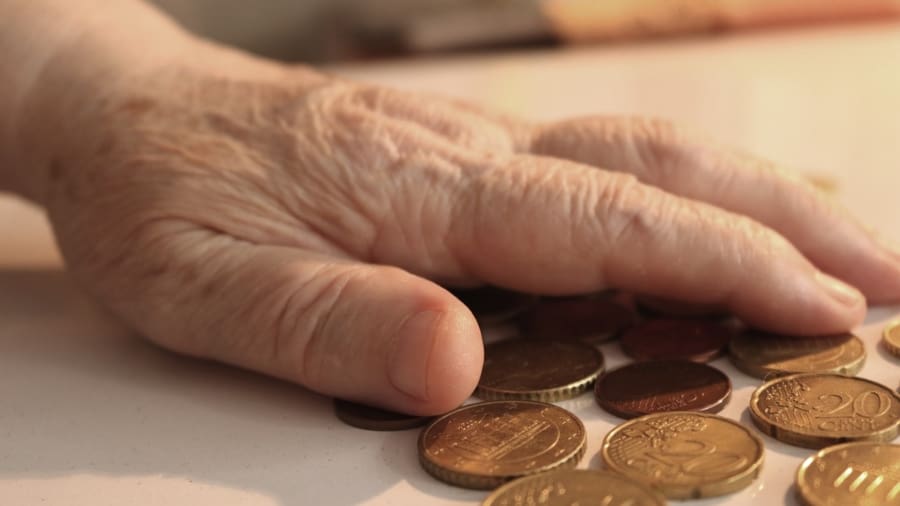This is not the first time I’ve written a piece on Finding Poland which covers the cost of living in Poland per month.
In another post, I have provided some insight into the average living cost in the city I live in – Gdańsk. In that post, also compare the cost of living in Gdańsk with the average monthly living cost in Kraków. I regularly update that post so do check it out for up-do-date information.
Of course, the world we now live in is a very different place than it was in 2021. I don’t have to mention which events have affected the cost of living and prices across the globe.
In July 2021, Numbeo revealed that people in Gdańsk had to contend with the highest cost of living in Poland. This is no longer the case, even though one must take data on Numbeo with a pinch of salt:

In general, I think that the cost of living in Gdańsk is generally representative of the cost of living in most other major Polish cities. Hence, the aim of this post is to share what I’ve noticed in Gdańsk in terms of rising prices over the past few year.
Do bear in mind that the estimates of living expenses I provide are extremely conservative.
A Breakdown of the Cost of Living per month in Poland
*The cost of living estimates I provide in this post are for a couple with a teenage child.
Let me begin with the area of apartment rental in Poland.
Apartment rental with a parking space (4700 zł)
As of May 11, 2024, the average rent per month for a one-bedroom apartment outside the city centre of Gdańsk is 2,600 zł (Numbeo). Frankly, I’d like to put that figure to the test by checking out the cost of renting apartments on Otodom. Otodom is the most well-known online property portal in Poland.
I’ve just run a search for flats in the district I live in, Piecki-Migowo. This district is around 4.5 km from the Main Town of Gdańsk. It’s not on the outskirts of the city.
What have I noticed? Well, there are hardly any apartments of any reasonable quality going for below 2,500 zł.
Flats with an area of 40-50 m2 are available to rent for around 2,800 zł in Piecki-Migowo.
As for the Main Town of Gdańsk in and around prime locations such as Szafarnia Street, my search informs me that it’d be tough to find a decent 40-50 m2 flat to rent in a building constructed in the last ten years for less than 3,200 zł.
If you have kids and need to rent out a two or three-bedroom apartment in a newer building in Gdańsk with an area of 70-90m2, you’ll have to pay at least 4,500 zł. To live in the Main Town and prime locations like Wrzeszcz and Przymorze, you will have to fork out as much as 6,000-7,000 zł for a larger apartment in a newer building.
I am the owner of a two-bedroom 75m2 property in Gdańsk.
For the purposes of calculating the monthly cost of living in Poland, let’s imagine that our couple will rent out my place together with a parking space. Based on current market trends in Gdańsk, the rent plus parking would come to:
4,700 zł.
Monthly utility bills
Now, we will add my monthly utility bills for you to get a much better picture of the cost of living in Poland per month.
Communal fees
The communal fees bill in Poland is called czynsz administracyjny. It covers elements such as electricity (inside the building), waste disposal, lift maintenance, the upkeep of green spaces around the building and water and canalisation.
Back in April 2019, when the previous owner of my flat showed me a recent communal fees bill, the fee was around 540 zł. This fee included maintenance costs for two parking spaces and a storage unit in the underground garage.
Fast forward to May 2024, and my communal fees bill is now a whopping 878 zł. I also have to pay an extra 249 zł for everything connected to the garage hall. Somehow, my Building Manager found a way to increase my communal fees by 28% from April to May 2024. I now have to pay 1,127 zł a month.


All in all, my monthly communal fees have gone up by around 109% since 2019.
1000 zł
Internet
It’s not expensive to have high-speed fibre-optic Internet in your home in Poland.
I’m with the provider Play (previously UPC).
At the time of writing, Play is offering fibre-optic Internet with a speed up to 600 Mb/s for 70 zł a month on a twelve-month contract. This offer is for clients who are new to Play. For those who are currently clients of Play, the price is 50 zł :
You also get around 35 Polish TV channels thrown in with the offer.
It only costs 80 zł extra if you want a no-contract Internet plan.
70 zł
Electricity
I receive my electricity bill every two months.
My bill for the period from 27 January, 2024, to 26 March, 2024, came to 357,78 zł for 374kWh of electricity use.
It’s worth mentioning that I work from home and we cook more or less every day.
175 zł (per month)
Mobile telephone
Frankly, I’ve never been interested in comparing offers provided by mobile phone operators in Poland.
I am with PLAY and sometimes pay a prepaid amount of 35 zł per month which gives me free calls and text messages. I also get 45 GB of Internet. I’m not exactly sure whether 45 GB is a lot or not. However, I’m not one for walking down the street with my head stuck in my phone all the time, so I think it’s enough.
105 zł (three people)
Grocery shopping in Poland
Every three months or so, I go to my local supermarket, Carrefour, to make a note of prices of staple foods for my post on food prices in Poland. Here are the prices I recorded in April 2024 compared with December 2023:

At first glance, you’re probably thinking that some of the prices don’t look that steep. However, many of the items in the table above have gone up by at least 30% since the start of 2021.
Overall, I think it’s in the area of grocery shopping that the cost of living in Poland per month is biting many people. It’s the same in every country I suppose.
1450 zł
Restaurants and coffee shops in Polish cities
If you wish to eat out at a reputable pizza restaurant, indulge yourself in Polish cuisine or visit a pierogarnia (dumpling restaurant) a few times a month, your wallet shouldn’t take a hit.
One of my favourite places to eat out in Gdańsk is the dumpling restaurant Pierogarnia Mandu.
Looking at Mandu’s tasty menu, one can eat out well in Gdańsk for around 35-40 zł. Hence, for a couple with a child, it should cost around 150 zł for three portions of pierogi and three soft drinks.
As for coffee, the price of a small cappuccino in Cukiernia Sowa is currently 14 zł. It was 9 zł a few years ago. My wife and I like our visits to Sowa, especially sitting outside on Długa Street in the summer. With these prices, I don’t think we’ll be going all that often this year.
On the basis of eating out and visiting a cafe for coffee and cake once a month, I think 250 zł is about right.
250 zł
Fuel and public transport in major Polish cities
It’s not expensive to buy a monthly pass to travel on public transport in Gdańsk and other major Polish cities.
At the time of writing, it costs 117 zł to buy a monthly pass valid on all days of the week to travel on regular, fast and night routes within Gdańsk city limits.
Surprisingly, a monthly travel pass in Gdańsk is cheaper than buying a pass in most other Polish cities.
I do pay 117 zł for a monthly public transport pass to get around Gdańsk. It’s a lot less hassle to take a tram into town or a bus to the district of Wrzeszcz, than it is to sit in traffic jams and worry about having to find a parking spot.
Let’s imagine that one half of our couple travels 15 km to and from work every day by car, and spends around 400 zł per month in total on petrol. Bear in mind that petrol prices in Poland seem to be lower than in neighbouring EU countries. The other half of the couple relies on public transport (117 zł). As for the teenager, the cost of a five-month term ticket (1.09-31.01 or 1.02-30.06) in Gdańsk is 278 zł. This works out at around 55 zł per month for ten months of the year.
572 zł
Comprehensive Car Insurance in Poland
In March 2024, I switched car insurance companies from PZU to Warta.
Warta’s offer for comprehensive car insurance for my 2020 Ford Kuga came to 3,001 zł. This was the fee if I made a one-off payment. It would have been more expensive if I opted to pay by monthly instalments.
I drive from Gdańsk to the Balkans a few times a year so I opted for the platinum (platynowy) variant of car assistance which gives me a bit more peace of mind.
I suppose it’s possible to grab yourself a decent comprehensive car insurance policy for around 200 zł a month if you don’t require the more expensive roadside assistance and car tyre insurance variants which I chose.
200 zł
Healthcare in Poland
My wife and I currently have access to public medical services offered by the National Health Fund (Narodowy Fundusz Zdrowia; NFZ). Hence, we have peace of mind knowing we can get emergency healthcare should we need it.
As for going to see a doctor, we tend to rely on private specialists. Most specialists in Gdańsk charge around 150-250 zł for an appointment.
I have some experience with searching for prices for private healthcare packages.
A few years ago, I was in contact with an agent from the healthcare provider, Medicover.
He was determinedly trying to sell me the provider’s Elite + package for several weeks. This package offers comprehensive outpatient care, unlimited home visits, hospital treatment and medical care overseas.
I was quoted a price of 653 zł per month to cover both my wife and me.
I didn’t doubt that the package was “fully comprehensive”. However, I was not willing to pay that sort of money.
In the future, we may look into buying a cheaper basic medical package which provides ambulance and emergency services and same day visits at Medicover Express. Hence, the ideal package to cover all that would be Standard+.
The annual fee for two adults is 2,544.48 zł. This has gone up by around 600 zł since August 2021. Add the fee for a teenager into the equation and the price goes up to 3548,88 zł per year.
If you are employed in Poland under a full-time employment contract (Umowa o pracę), you will be covered by the NFZ via the health insurance contributions you have to pay.
296 zł per month (medical package for two adults and a teenage child)
Adding things up
First of all, let’s recap. Our imaginary couple with a teenage child are renting a 75m2 flat in a block of flats in Gdańsk. The building was constructed in 2013. One half of the couple travels to work while the other half relies on public transport. Regarding the teenage child, his parents pay for a five-month semestral public transport ticket twice a year which comes to 556 zł (2×278 zł).
I will now add things up so you can get a better sense of the cost of living in Poland per month based on two adults with a child:
- Rent with a parking space – 4700 zl
- Communal fees – 900 zł
- Internet – 70 zł
- Electricity – 175 zł
- Mobile telephone (family of three) – 105 zł
- Grocery shopping – 1450 zł
- Restaurants and cafes – 250 zł
- Petrol and monthly public transport travel passes – 572 zł
- Comprehensive car insurance – 200 zł
- Basic private healthcare package – 296 zł
TOTAL = 8,718 zł
Frankly, I think I’ve been quite modest with some of the estimates I’ve provided. I’m sure that many people like to go out for a meal and for coffee more than once a month. Moreover, the estimate for fuel expenses and monthly grocery shopping may also be on the low side. The only figure that may be on the high side is the rent. Not many families choose to rent larger apartments with rents over 4000 zł – be it in Gdańsk, Warsaw or any other Polish city or town.
Of course, you would need to add the cost of cosmetics and other leisure activities to the total estimate. Let’s not forget that I haven’t considered the cost of buying clothes and all the other equipment and materials a child needs for school.
Overall, I may conclude that most Polish couples (with or without children) might struggle to get by if only one person works.
Bonus
It’s certainly not all doom and gloom when it comes to monthly living expenses in Poland, as I write about in this post:
What is cheap in Poland?

